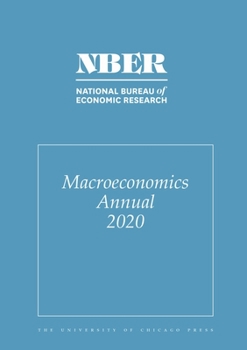Nber Macroeconomics Annual 2020: Volume 35
(Book #35 in the NBER Macroeconomics Annual Series)
NBER Macroeconomics Annual 2020 presents research by leading scholars on central issues in contemporary macroeconomics. George-Marios Angeletos, Zhen Huo, and Karthik Sastry ask how to model expectations without rational expectations. They find that in response to business cycle shocks, expectations underreact initially but eventually overshoot, which in their view favors models with dispersed, noisy information and overextrapolation of expectations. Next, Esteban Rossi-Hansberg, Pierre-Daniel Sarte, and Nicholas Trachter contrast the patterns of rising aggregate firm market concentration with falling market concentration over time at the local level. Some associate rising concentration with less competition and more market power, but because most product markets are local, studying changes in local competition, as opposed to trends in aggregate competition, provides important insights. Adam Guren, Alisdair McKay, Emi Nakamura, and Jón Steinsson develop a novel econometric procedure to recover structural parameters using cross-region variation, for example, to estimate direct effects of housing wealth changes on individual household consumption. To avoid confounding direct and indirect effects, the authors isolate the direct effect of house price changes on consumption by using other estimates of demand multipliers from the local government spending literature to deflate estimates of the total effect of local consumption on local house prices. Peter Klenow and Huiyu Li examine the sources of reduced productivity growth by quantifying the contribution of innovation to economic growth. They find that young firms generate roughly half the productivity growth, most of the changes in productivity during the mid-1990s are accounted for by older firms, and most growth results from quality improvements on incumbents' own products. In the fifth chapter, Fatih Guvenen, Greg Kaplan, and Jae Song use detailed micro panel data from the Social Security Administration to assess the progress women have made into the top 1% and top 0.1% of the income distribution over time. Finally, Joachim Hubmer, Per Krusell, and Anthony Smith Jr. explore the reasons for growing wealth inequality across the developed world. They argue that the significant drop in tax progressivity starting in the late 1970s was the most important source of growing wealth inequality in the United States. The sharp observed increases in earnings inequality and the falling labor share cannot account for the bulk of the increase in wealth inequality.
Format:Paperback
Language:English
ISBN:022680268X
ISBN13:9780226802688
Release Date:March 2021
Publisher:University of Chicago Press
Length:512 Pages
Customer Reviews
0 rating





